Application of Overground Rock Film Mulching (ORFM) Technology in Karst Rocky Desertification Farmland: Improving Soil Moisture Environment and Crop Root Growth
Abstract
1. Introduction
2. Materials and Methods
2.1. Study Area
2.2. Experimental Design
2.2.1. Application of ORFM
2.2.2. Dye Tracer Test
2.2.3. Soil Moisture Measurement
2.2.4. Root Characteristic Measurement
- Root Biomass
- Root Radial Extent
- Root Bifurcation Ratio
3. Results
3.1. Soil Water Flow Behavior
3.2. Soil Water Content and Spatiotemporal Heterogeneity
3.3. Root Characteristics
3.3.1. Root Biomass
3.3.2. Root Radial Extent
3.3.3. Root Bifurcation Ratio
4. Discussion
4.1. Effect of ORFM on Soil Water
4.2. Effects of ORFM on Root Characteristics
4.3. Application of ORFM
5. Conclusions
Author Contributions
Funding
Data Availability Statement
Acknowledgments
Conflicts of Interest
References
- Zhang, Y.Q.; Li, Z.R.; Wu, T.; Chen, F.X.; Xu, M.Y.; Wang, Y.; He, S.Q.; Tan, B.; Hou, G.R.; Luo, Z.T.; et al. Soil erosion rates on sloping cropland fragment underlain by contrasting lithologies. Catena 2023, 220, 106622. [Google Scholar] [CrossRef]
- Chen, L.; Zhang, K.L.; Li, Y.T. Spatial variations in soil erodibility induced by rock outcropping on sloping cropland in the karst region of Southwest China. Geoderma 2023, 440, 116705. [Google Scholar] [CrossRef]
- Wei, B.; Li, Z.W.; Duan, L.X.; Gu, Z.K.; Liu, X.M. Vegetation types and rainfall regimes impact on surface runoff and soil erosion over 10 years in karst hillslopes. Catena 2023, 232, 107443. [Google Scholar] [CrossRef]
- Liu, M.; Han, G.L.; Zhang, Q. Effects of agricultural abandonment on soil aggregation, soil organic carbon storage and stabilization: Results from observation in a small karst catchment, Southwest China. Agric. Ecosyst. Environ. 2020, 288, 106719. [Google Scholar] [CrossRef]
- Yang, L.Y.; Zhao, C.W.; Jiao, S.L.; Li, S.; Wang, L.; Li, Y.J. Reconstructing spatial pattern of historical cropland in karst areas of Guizhou, Southwest China. Sci. Rep. 2022, 12, 22391. [Google Scholar] [CrossRef] [PubMed]
- Li, D.J.; Wen, L.; Yang, L.Q.; Luo, P.; Xiao, K.C.; Chen, H.; Zhang, W.; He, X.Y.; Chen, H.S.; Wang, K.L. Dynamics of soil organic carbon and nitrogen following agricultural abandonment in a karst region. J. Geophys. Res. Biogeosci. 2017, 122, 230–242. [Google Scholar] [CrossRef]
- Zhang, X.Q.; Hu, M.C.; Guo, X.Y.; Yang, H.; Zhang, Z.K.; Zhang, K.L. Effects of topographic factors on runoff and soil loss in Southwest China. Catena 2018, 160, 394–402. [Google Scholar] [CrossRef]
- Luo, D.; Xiong, K.N.; Wu, C.X.; Gu, X.; Wang, Z.H. Soil moisture and nutrient changes of agroforestry in karst plateau mountain: A monitoring example. Agronomy 2023, 13, 94. [Google Scholar] [CrossRef]
- Qin, L.Y.; Bai, X.Y.; Wang, S.J.; Zhou, D.Q.; Li, Y.; Peng, T.; Tian, Y.C.; Luo, G.J. Major problems and solutions on surface water resource utilisation in karst mountainous areas. Agric. Water Manag. 2015, 159, 55–65. [Google Scholar] [CrossRef]
- Liu, Y.; Shan, F.Z.; Yue, H.; Wang, X. Characteristics of drought propagation and effects of water resources on vegetation in the karst area of Southwest China. Sci. Total Environ. 2023, 891, 164663. [Google Scholar] [CrossRef]
- Dai, Q.H.; Peng, X.D.; Yang, Z.; Zhao, L.S. Runoff and erosion processes on bare slopes in the Karst Rocky Desertification Area. Catena 2017, 152, 218–226. [Google Scholar] [CrossRef]
- Zhu, D.Y.; Xiong, K.N.; Xiao, H.; Gu, X.P. Variation characteristics of rainfall erosivity in Guizhou Province and the correlation with the El Nino Southern Oscillation. Sci. Total Environ. 2019, 691, 835–847. [Google Scholar] [CrossRef] [PubMed]
- Peng, X.D.; Dai, Q.H. Drivers of soil erosion and subsurface loss by soil leakage during karst rocky desertification in SW China. Int. Soil Water Conserv. Res. 2022, 10, 217–227. [Google Scholar] [CrossRef]
- Wang, Z.H.; Luo, D.; Xiong, K.N.; Gu, X.; Zhu, Z.Z. Studies on Hydrological processes on karst slopes for control of soil and water loss. Sustainability 2022, 14, 5789. [Google Scholar] [CrossRef]
- Wang, J.X.; Zou, B.P.; Liu, Y.; Tang, Y.Q.; Zhang, X.B.; Yang, P. Erosion-creep-collapse mechanism of underground soil loss for the karst rocky desertification in Chenqi village, Puding county, Guizhou, China. Environ. Earth Sci. 2014, 72, 2751–2764. [Google Scholar] [CrossRef]
- Zeng, F.M.; Jiang, Z.C.; Shen, L.N.; Chen, W.; Yang, Q.Y.; Zhang, C. Assessment of multiple and interacting modes of soil loss in the karst critical zone, Southwest China (SWC). Geomorphology 2018, 322, 97–106. [Google Scholar] [CrossRef]
- Williams, P.W. The role of the epikarst in karst and cave hydrogeology: A review. Int. J. Speleol. 2008, 37, 1–10. [Google Scholar] [CrossRef]
- He, J.H.; Cao, Y.; Zhang, K.L.; Xiao, S.Z.; Cao, Z.H. Soil loss through fissures and its responses to rainfall based on drip water monitoring in karst caves. J. Hydrol. 2023, 617, 129000. [Google Scholar] [CrossRef]
- Fu, Z.Y.; Chen, H.S.; Xu, Q.X.; Jia, J.T.; Wang, S.; Wang, K.L. Role of epikarst in near-surface hydrological processes in a soil mantled subtropical dolomite karst slope: Implications of field rainfall simulation experiments. Hydrol. Process. 2016, 30, 795–811. [Google Scholar] [CrossRef]
- Yang, J.; Chen, H.S.; Nie, Y.P.; Wang, K.L. Dynamic variations in profile soil water on karst hillslopes in Southwest China. Catena 2019, 172, 655–663. [Google Scholar] [CrossRef]
- Chen, X.; Zhang, Z.C.; Chen, X.H.; Shi, P. The impact of land use and land cover changes on soil moisture and hydraulic conductivity along the karst hillslopes of southwest China. Environ. Earth Sci. 2009, 59, 811–820. [Google Scholar] [CrossRef]
- Zhang, X.B.; Bai, X.Y.; He, X.B. Soil creeping in the weathering crust of carbonate rocks and underground soil losses in the karst mountain areas of southwest China. Carbonates Evaporites 2011, 26, 149–153. [Google Scholar] [CrossRef]
- Zhang, S.Q.; Ma, Q.H.; Qihua, K.; Zhang, K.L.; Zhu, T. Effects of rock outcrops on runoff and erosion from karst slopes under simulated rainfall. Land Degrad. Dev. 2024, 35, 949–967. [Google Scholar] [CrossRef]
- Ao, L.M.; Wu, Y.Q.; Xu, Q.X.; Huang, G.L.; Zheng, J.D.; Dai, J.F.; Fu, Z.Y.; Chen, H.S. Subsurface flow aggravates the soil erosion on steep slopes in karst post-mining areas. J. Hydrol. Reg. Stud. 2024, 51, 101667. [Google Scholar] [CrossRef]
- Zhao, Z.M.; Shen, Y.X.; Jiang, R.H.; Wang, Q.H. Rock outcrops change infiltrability and water flow behavior in a karst soil. Vadose Zone J. 2020, 19, e10002. [Google Scholar] [CrossRef]
- Arbel, Y.; Greenbaum, N.; Lange, J.; Inbar, M. Infiltration processes and flow rates in developed karst vadose zone using tracers in cave drips. Earth Surf. Process. Landf. 2010, 35, 1682–1693. [Google Scholar] [CrossRef]
- Sohrt, J.; Ries, F.; Sauter, M.; Lange, J. Significance of preferential flow at the rock soil interface in a semi-arid karst environment. Catena 2014, 123, 1–10. [Google Scholar] [CrossRef]
- Wu, Q.L.; Liang, H.; Xiong, K.N.; Li, R. Effectiveness of monitoring methods for soil leakage loss in karst regions. Environ. Earth Sci. 2021, 80, 278. [Google Scholar] [CrossRef]
- Zhou, L.G.; Wang, X.D.; Wang, Z.Y.; Zhang, X.M.; Chen, C.; Liu, H.F. The challenge of soil loss control and vegetation restoration in the karst area of southwestern China. Int. Soil Water Conserv. Rev. 2020, 8, 26–34. [Google Scholar] [CrossRef]
- Green, S.M.; Dungait, J.A.J.; Tu, C.L.; Buss, H.L.; Sanderson, N.; Hawkes, S.J.; Xing, K.X.; Yue, F.J.; Hussey, V.L.; Peng, J.; et al. Soil functions and ecosystem services research in the Chinese karst Critical Zone. Chem. Geol. 2019, 527, 119107. [Google Scholar] [CrossRef]
- Qin, R.J.; Noulas, C.; Herrera, J.M. Morphology and distribution of wheat and maize roots as affected by tillage systems and soil physical parameters in temperate climates: An overview. Arch. Agron. Soil Sci. 2018, 64, 747–762. [Google Scholar] [CrossRef]
- Warren, J.M.; Hanson, P.J.; Iversen, C.M.; Kumar, J.; Walker, A.P.; Wullschleger, S.D. Root structural and functional dynamics in terrestrial biosphere models-evaluation and recommendations. New Phytol. 2015, 205, 59–78. [Google Scholar] [CrossRef] [PubMed]
- Metcalfe, D.B.; Meir, P.; Aragao, L.E.O.C.; da Costa, A.C.L.; Braga, A.P.; Gonçalves, P.H.L.; Silva, J.D.; de Almeida, S.S.; Dawson, L.A.; Malhi, Y.; et al. The effects of water availability on root growth and morphology in an Amazon rainforest. Plant Soil 2008, 311, 189–199. [Google Scholar] [CrossRef]
- Zhang, J.; Wang, J.M.; Chen, J.Y.; Song, H.Y.; Li, S.H.; Zhao, Y.J.; Tao, J.P.; Liu, J.C. Soil moisture determines horizontal and vertical root extension in the perennial grass Lolium perenne L. growing in karst soil. Front. Plant Sci. 2019, 10, 629. [Google Scholar] [CrossRef] [PubMed]
- Nie, Y.P.; Chen, H.S.; Wang, K.L.; Ding, Y.L. Rooting characteristics of two widely distributed woody plant species growing in different karst habitats of southwest China. Plant Ecol. 2014, 215, 1099–1109. [Google Scholar] [CrossRef]
- Zhou, C.W.; Cui, W.J.; Yuan, T.; Cheng, H.Y.; Su, Q.; Wei, H.X.; Guo, P. Root foraging behavior of two agronomical herbs subjected to heterogeneous P pattern and high Ca stress. Agronomy 2022, 12, 624. [Google Scholar] [CrossRef]
- Li, Q.; Umer, M.; Guo, Y.; Shen, K.P.; Xia, T.T.; Xu, X.Y.; Han, X.; Ren, W.D.; Sun, Y.; Wu, B.L.; et al. Karst soil patch heterogeneity with gravels promotes plant root development and nutrient utilization associated with Arbuscular mycorrhizal Fungi. Agronomy 2022, 12, 1063. [Google Scholar] [CrossRef]
- Liu, L.; Guo, Y.F.; Liu, X.Y.; Yao, Y.F.; Qi, W. Relationship between the roots of Hippophae rhamnoides at different stump heights and the root microenvironment in feldspathic sandstone areas. PeerJ 2023, 11, e14819. [Google Scholar] [CrossRef]
- Li, L.X.; Deng, X.H.; Zhang, T.; Tian, Y.L.; Ma, X.Q.; Wu, P.F. Propagation methods decide root architecture of chinese fir: Evidence from tissue culturing, rooted cutting and seed germination. Plants 2022, 11, 2472. [Google Scholar] [CrossRef]
- Liu, L.; Guo, Y.F.; Liu, X.Y.; Yao, Y.F.; Qi, W. Stump height after regenerative cutting of sea-buckthorn (Hippophae rhamnoides) affects fine root architecture and rhizosphere soil stoichiometric properties. Rhizosphere 2022, 24, 100602. [Google Scholar] [CrossRef]
- Duque, L.O.; Villordon, A. Root branching and nutrient efficiency: Status and way forward in root and tuber crops. Front. Plant Sci. 2019, 10, 237. [Google Scholar] [CrossRef] [PubMed]
- Liu, Y.Y.; Wei, X.L.; Zhou, Z.J.; Shao, C.C.; Su, S.C. Influence of heterogeneous karst microhabitats on the root foraging ability of chinese windmill palm (Trachycarpus fortunei) seedlings. Int. J. Environ. Res. Public Health 2020, 17, 434. [Google Scholar] [CrossRef] [PubMed]
- Zhao, Z.M.; Wang, Q.H. Effect of rock film mulching on preferential flow at rock–soil interfaces in rocky karst areas. Water 2023, 15, 1775. [Google Scholar] [CrossRef]
- Zhao, Z.M.; Deng, J.B.; Zhang, J.; Shen, Y.X. Effects of film-mulched rock outcrops on rainwater redistribution and maize growth in the cropland of a rocky karst area. Water 2024, 16, 254. [Google Scholar] [CrossRef]
- Shen, Y.X.; Wang, Q.H.; Zhao, Z.M.; Yuan, C. Fine-scale effect of karst rock outcrops on adjacent soil and plant communities in Southwest China. Catena 2022, 219, 106592. [Google Scholar] [CrossRef]
- Göransson, H.; Edwards, P.J.; Perreijn, K.; Smittenberg, R.H.; Venterink, H.O. Rocks create nitrogen hotspots and N:P heterogeneity by funnelling rain. Biogeochemistry 2014, 121, 329–338. [Google Scholar] [CrossRef]
- Fan, C.H.; Zhao, L.S.; Hou, R.; Fang, Q.; Zhang, J.X. Quantitative analysis of rainwater redistribution and soil loss at the surface and belowground on karst slopes at the microplot scale. Catena 2023, 227, 107113. [Google Scholar] [CrossRef]
- Shen, Y.X.; Wang, D.J.; Chen, Q.Q.; Tang, Y.Y.; Chen, F.J. Large heterogeneity of water and nutrient supply derived from runoff of nearby rock outcrops in karst ecosystems in SW China. Catena 2019, 172, 125–131. [Google Scholar] [CrossRef]
- Liu, Y.H.; Xu, Z.; Duffy, R.; Chen, W.L.; An, S.Q.; Liu, S.R.; Liu, F.D. Analyzing relationships among water uptake patterns, rootlet biomass distribution and soil water content profile in a subalpine shrubland using water isotopes. Eur. J. Soil Biol. 2011, 47, 380–386. [Google Scholar] [CrossRef]
- Wu, G.L.; Zhang, Z.N.; Wang, D.; Shi, Z.H.; Zhu, Y.J. Interactions of soil water content heterogeneity and species diversity patterns in semi-arid steppes on the Loess Plateau of China. J. Hydrol. 2014, 519, 1362–1367. [Google Scholar] [CrossRef]
- Chairungsee, N.; Gay, F.; Thaler, P.; Kasemsap, P.; Thanisawanyangkura, S.; Chantuma, A.; Jourdan, C. Impact of tapping and soil water status on fine root dynamics in a rubber tree plantation in Thailand. Front. Plant Sci. 2014, 4, 538. [Google Scholar] [CrossRef] [PubMed]
- Tumber-Dávila, S.J.; Schenk, H.J.; Du, E.Z.; Jackson, R.B. Plant sizes and shapes above and belowground and their interactions with climate. New Phytol. 2022, 235, 1032–1056. [Google Scholar] [CrossRef] [PubMed]
- Zhao, Y.J.; Li, Z.; Zhang, J.; Song, H.Y.; Liang, Q.H.; Tao, J.P.; Cornelissen, J.H.C.; Liu, J.C. Do shallow soil, low water availability, or their combination increase the competition between grasses with different root systems in karst soil? Environ. Sci. Pollut. Res. 2017, 24, 10640–10651. [Google Scholar] [CrossRef] [PubMed]
- Ma, X.Y.; Chen, H.S.; Nie, Y.P. Common species maintain a large root radial extent and a stable resource use status in soil-limited environments: A case study in subtropical China. Front. Plant Sci. 2020, 11, 1260. [Google Scholar] [CrossRef] [PubMed]
- Yang, Y.; McCormack, M.L.; Hu, H.; Bao, W.K.; Li, F.L. Linking fine-root architecture, vertical distribution and growth rate in temperate mountain shrubs. Oikos 2023, 2023. [Google Scholar] [CrossRef]
- He, X.S.; Zhang, Y.L.; Liu, Z.H.; Wei, D.; Liang, G.; Liu, H.T.; Xi, B.D.; Huang, Z.B.; Ma, Y.; Xing, B.S. Interaction and coexistence characteristics of dissolved organic matter with toxic metals and pesticides in shallow groundwater. Environ. Pollut. 2020, 258, 113736. [Google Scholar] [CrossRef]
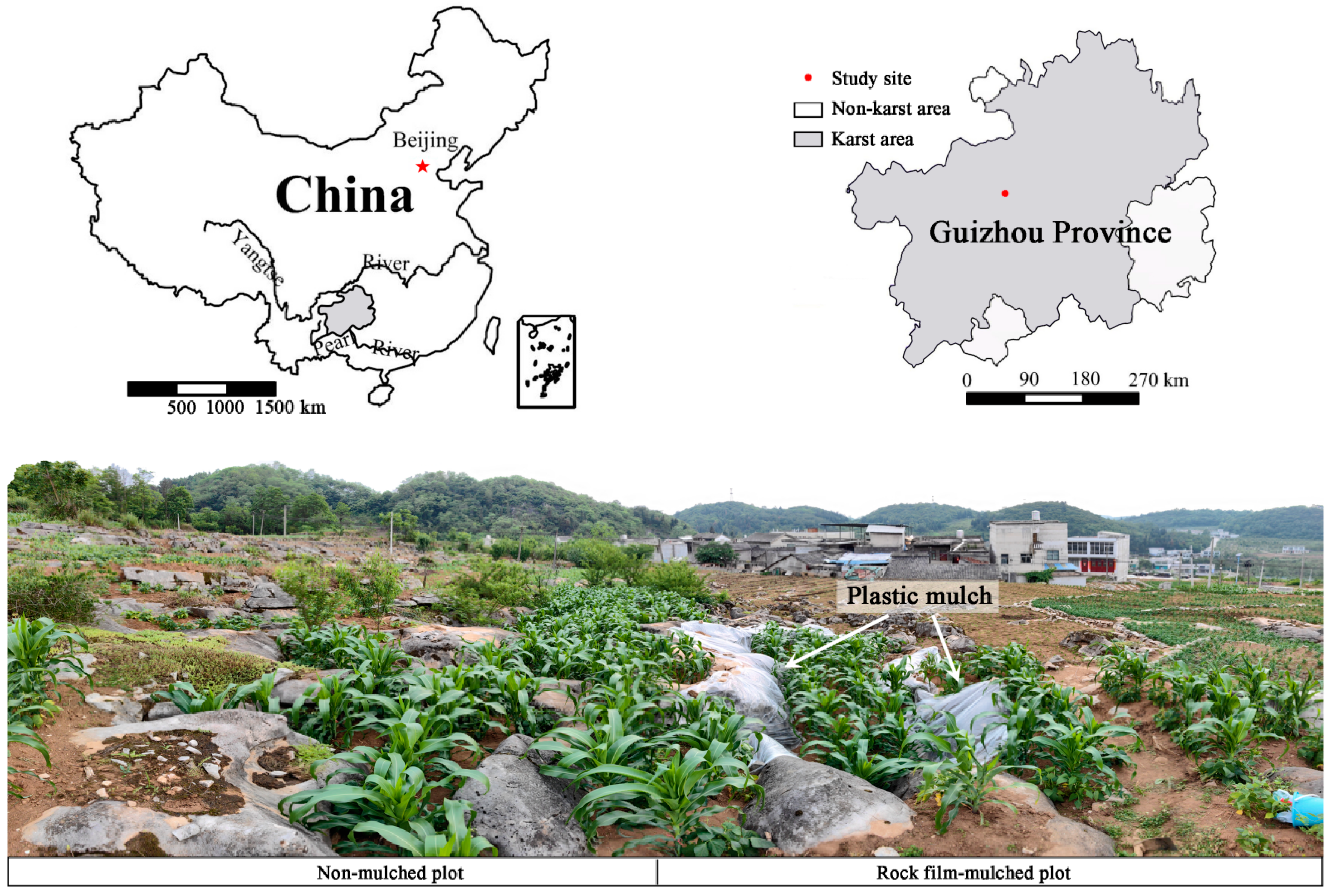
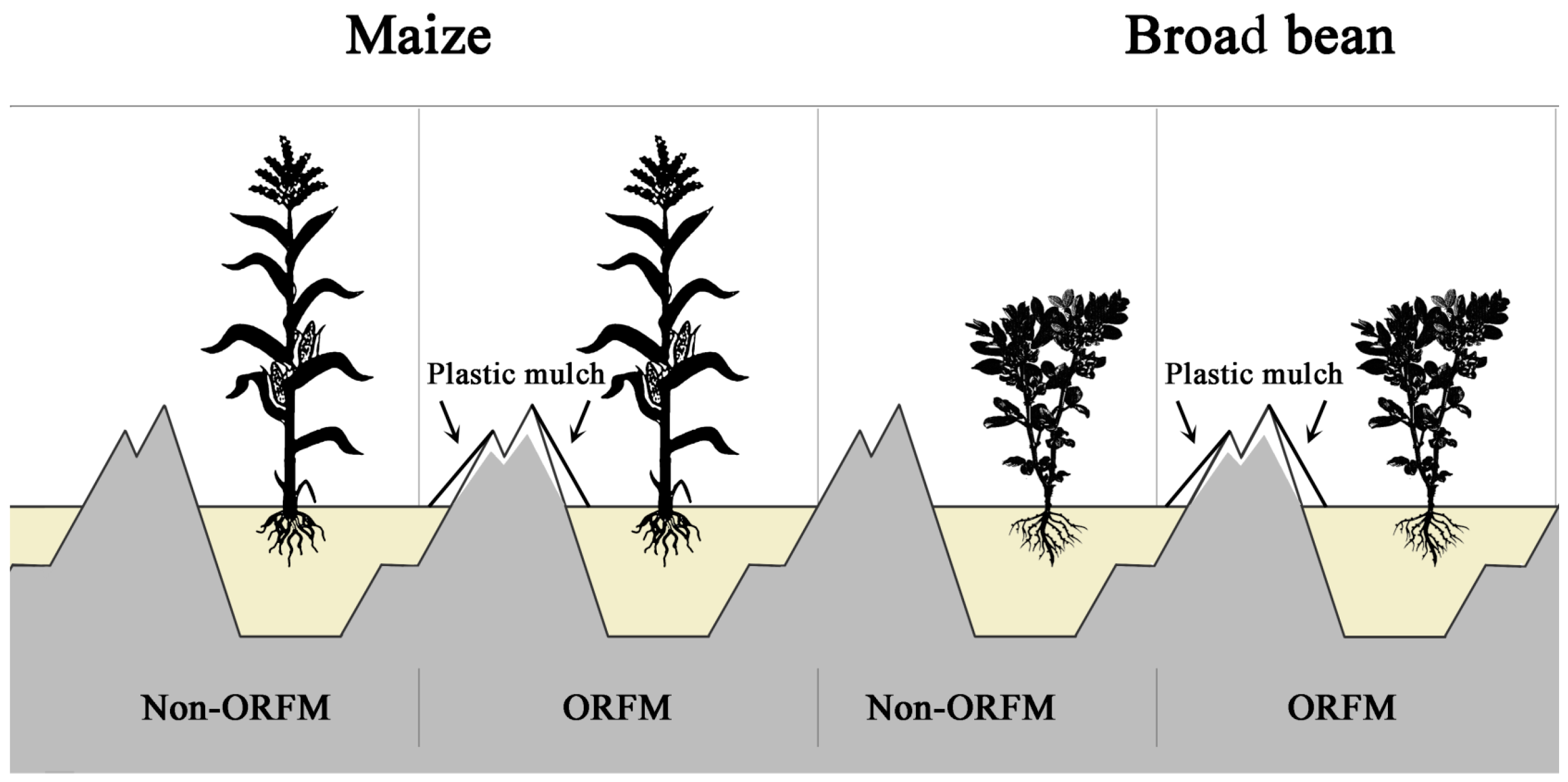
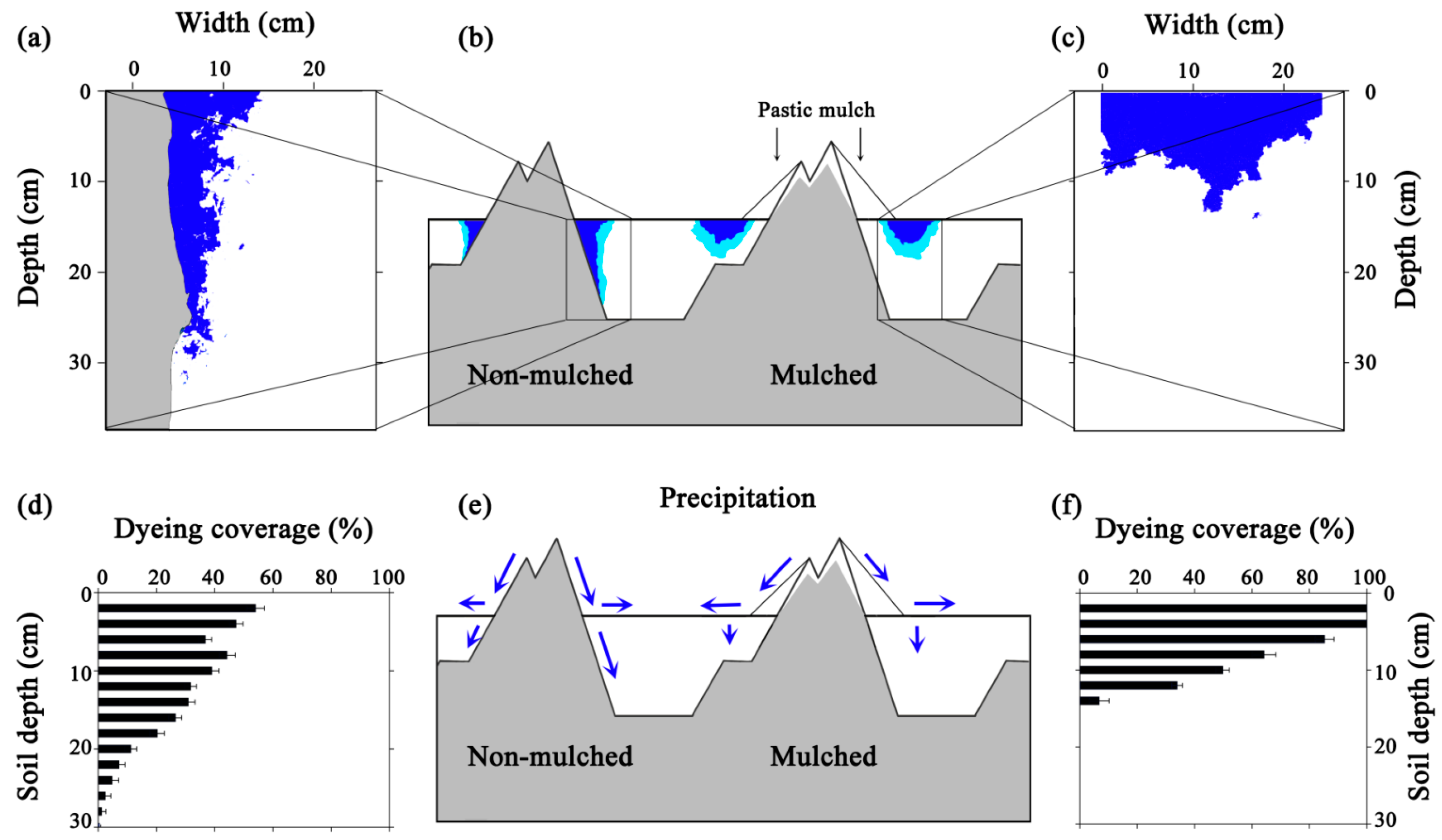


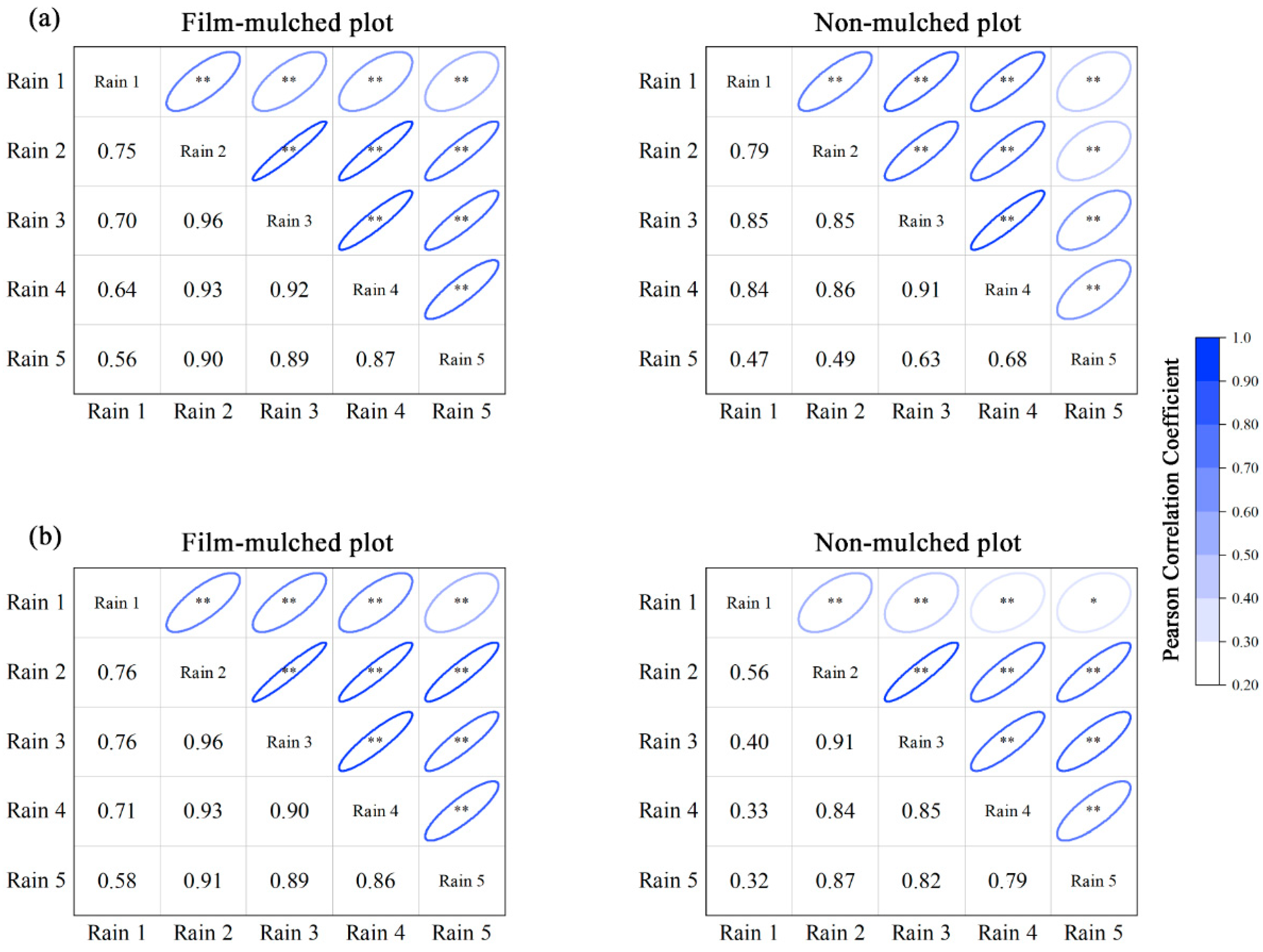

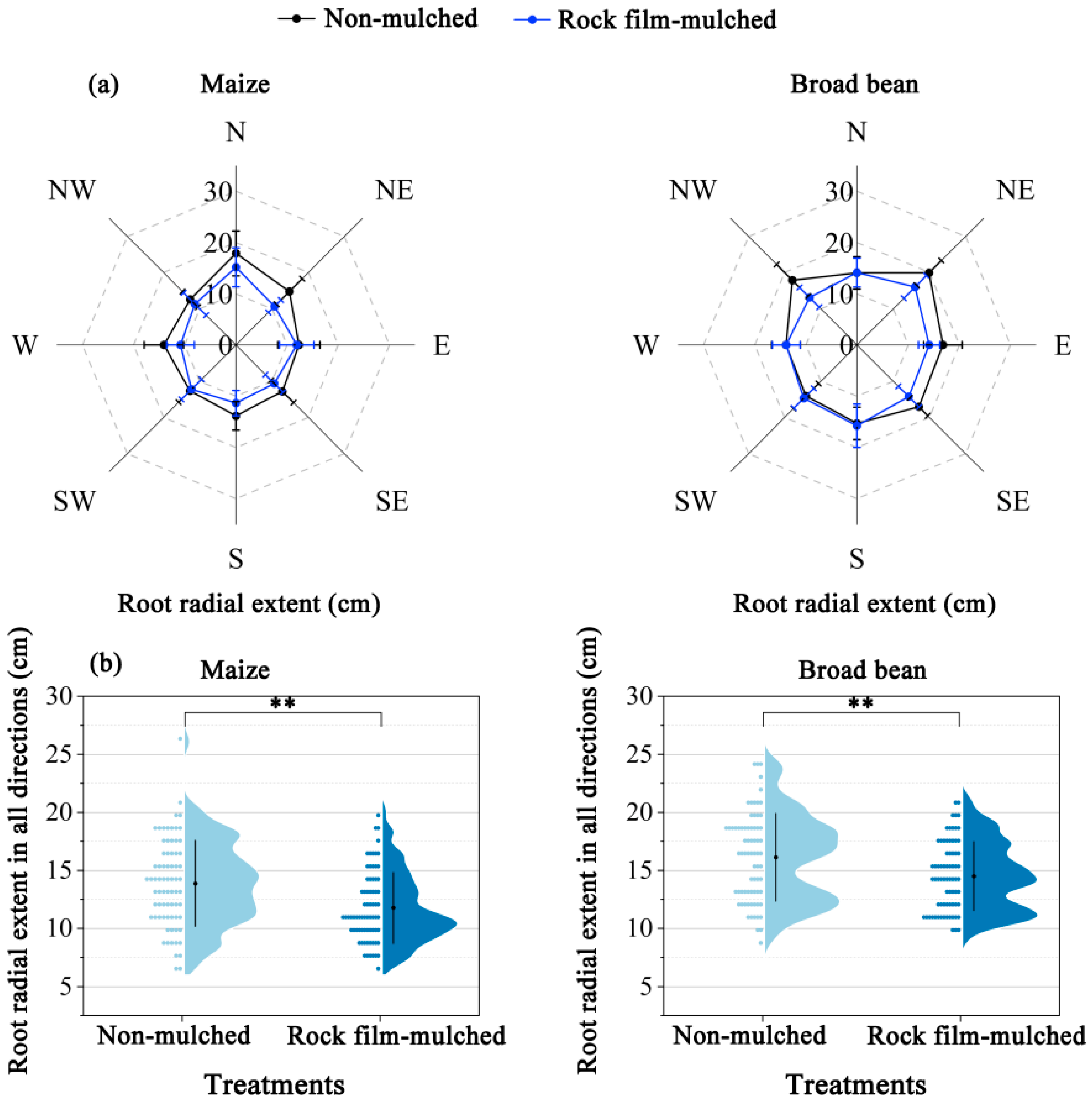
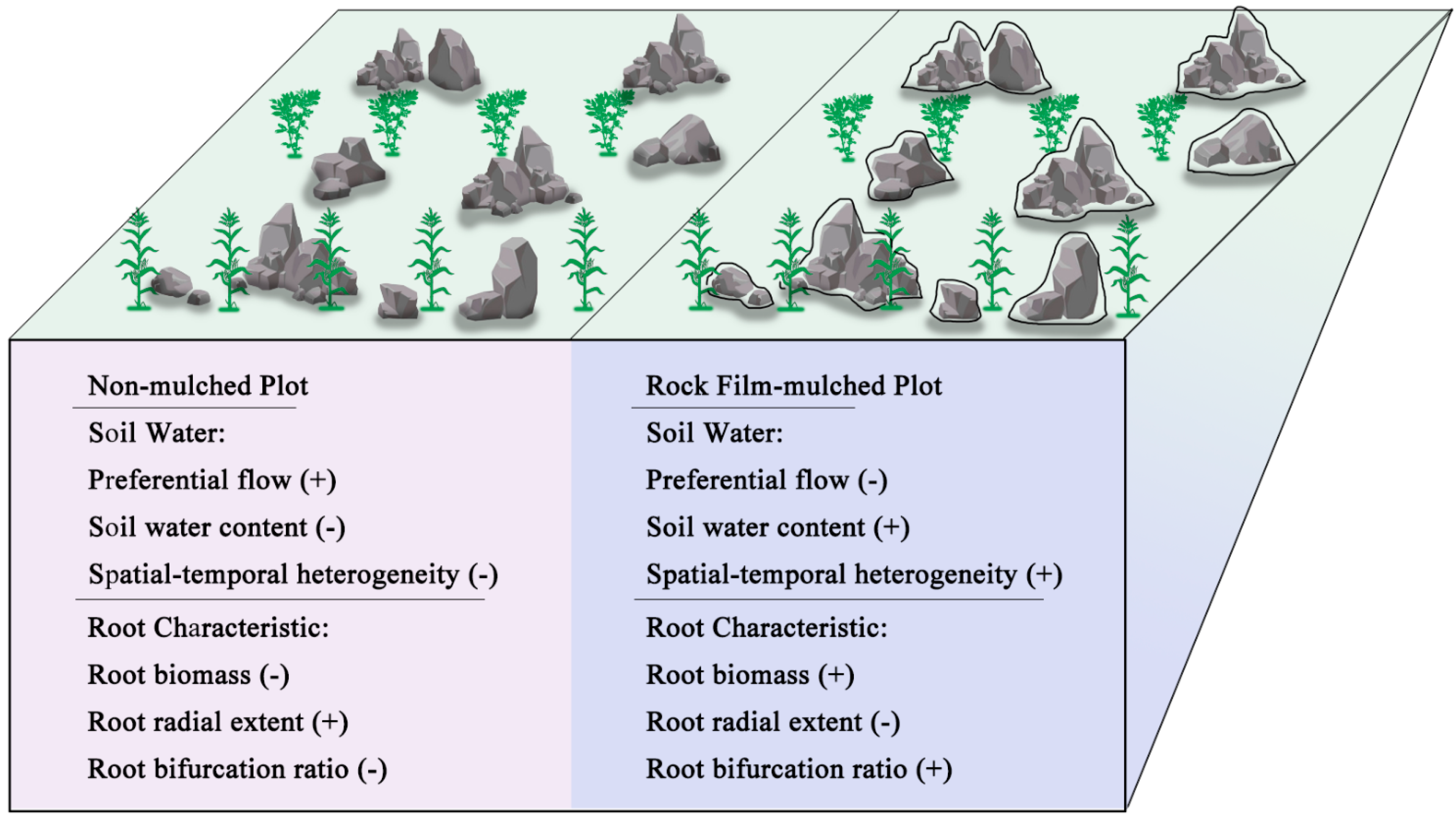
| Soil Horizon | Depth (cm) | Soil Particle Composition (%) | Soil Texture (USDA System) | Bulk Density (g·cm−3) | Initial Water Content (% vol.) | ||
|---|---|---|---|---|---|---|---|
| 0.05~2 mm | 0.002~0.05 mm | <0.002 mm | |||||
| A | 0~15 | 17.33 ± 1.75 | 49.49 ± 1.08 | 33.17 ± 1.06 | Silty clay loam | 1.13 ± 0.02 b | 11.07 ± 0.23 b |
| B | >15 | 7.39 ± 0.93 | 45.27 ± 0.60 | 47.34 ± 0.58 | Silty clay | 1.27 ± 0.02 a | 14.18 ± 0.49 a |
| Treatments | Dyeing Width | Dyeing Depth | Dyeing Coverage |
|---|---|---|---|
| Mulched | 24.97 ± 0.53 a | 12.82 ± 0.57 b | 29.33 ± 0.68 a |
| Non-mulched | 10.80 ± 0.55 b | 24.05 ± 1.30 a | 23.86 ± 0.61 b |
| Rainfall Events | Soil Water Content (% vol.) | |||
|---|---|---|---|---|
| The First Day after Rain | The First Week after Rain | |||
| Non-Mulched | Mulched | Non-Mulched | Mulched | |
| 1 | 22.92 ± 0.27 b | 24.31 ± 0.38 a | 18.69 ± 0.28 b | 20.32 ± 0.42 a |
| 2 | 28.63 ± 0.24 b | 32.88 ± 0.36 a | 24.76 ± 0.27 b | 27.65 ± 0.39 a |
| 3 | 28.25 ± 0.23 b | 31.21 ± 0.35 a | 23.61 ± 0.29 b | 26.34 ± 0.38 a |
| 4 | 31.16 ± 0.24 b | 34.66 ± 0.37 a | 26.73 ± 0.30 b | 29.33 ± 0.41 a |
| 5 | 32.44 ± 0.26 b | 36.98 ± 0.38 a | 27.68 ± 0.32 b | 33.54 ± 0.40 a |
| CVT (%) | 12.77 | 15.02 | 14.48 | 17.55 |
| Crops | Plots Type | Rb | Ri/Ri+1 | |
|---|---|---|---|---|
| R1/R2 | R2/R3 | |||
| Maize | Mulched | 2.84 ± 0.02 a | 1.65 ± 0.04 a | 4.81 ± 0.06 a |
| Non-mulched | 2.41 ± 0.01 b | 1.47 ± 0.03 b | 3.78 ± 0.04 b | |
| Broad bean | Mulched | 1.74 ± 0.05 a | 1.56 ± 0.03 a | 1.95 ± 0.06 a |
| Non-mulched | 1.62 ± 0.03 b | 1.41 ± 0.02 b | 1.84 ± 0.05 b | |
Disclaimer/Publisher’s Note: The statements, opinions and data contained in all publications are solely those of the individual author(s) and contributor(s) and not of MDPI and/or the editor(s). MDPI and/or the editor(s) disclaim responsibility for any injury to people or property resulting from any ideas, methods, instructions or products referred to in the content. |
© 2024 by the authors. Licensee MDPI, Basel, Switzerland. This article is an open access article distributed under the terms and conditions of the Creative Commons Attribution (CC BY) license (https://creativecommons.org/licenses/by/4.0/).
Share and Cite
Zhao, Z.; Zhang, J.; Liu, R. Application of Overground Rock Film Mulching (ORFM) Technology in Karst Rocky Desertification Farmland: Improving Soil Moisture Environment and Crop Root Growth. Agronomy 2024, 14, 1265. https://doi.org/10.3390/agronomy14061265
Zhao Z, Zhang J, Liu R. Application of Overground Rock Film Mulching (ORFM) Technology in Karst Rocky Desertification Farmland: Improving Soil Moisture Environment and Crop Root Growth. Agronomy. 2024; 14(6):1265. https://doi.org/10.3390/agronomy14061265
Chicago/Turabian StyleZhao, Zhimeng, Jin Zhang, and Rui Liu. 2024. "Application of Overground Rock Film Mulching (ORFM) Technology in Karst Rocky Desertification Farmland: Improving Soil Moisture Environment and Crop Root Growth" Agronomy 14, no. 6: 1265. https://doi.org/10.3390/agronomy14061265
APA StyleZhao, Z., Zhang, J., & Liu, R. (2024). Application of Overground Rock Film Mulching (ORFM) Technology in Karst Rocky Desertification Farmland: Improving Soil Moisture Environment and Crop Root Growth. Agronomy, 14(6), 1265. https://doi.org/10.3390/agronomy14061265






